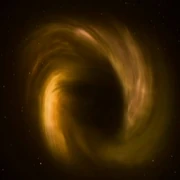
A subspace sinkhole
A subspace sinkhole was a naturally-occurring phenomenon capable of producing an extremely strong gravity well, which posed a potential hazard to any spacecraft which navigated too close. Much like quantum singularities, subspace sinkholes were monodirectional, which meant they prevented escape for any ship pulled inside. Extreme gravimetric shear from a sinkhole could prevent the formation of a stable warp field, which further decreased the chances of escape.
The USS Voyager encountered a subspace sinkhole in the Delta Quadrant in 2375, while searching for a missing shuttlecraft manned by Lieutenant Commander Tuvok, Ensign Tom Paris, and The Doctor. Utilizing their multispatial probe, the Voyager crew determined that the sinkhole was approximately six hundred meters in diameter, and circumscribed a subspace zone containing a type-G sun and three planets, on one of which the shuttlecraft had crashed. In addition, the sinkhole was determined to be out of phase with normal space, making it extremely difficult to detect. Analyzing the data further, the crew discovered that a temporal differential with a ratio of 0.4744 seconds per minute resulted in Tuvok, Paris, and The Doctor experiencing approximately one month for every day which passed in normal space.
As the crew attempted a rescue operation, they encountered a starship commanded by Yost, supervisor of Renovation Team Nova, who was on a mission to seal the sinkhole. As Yost fired antigraviton beams at the sinkhole, the Voyager crew managed to use the multispatial probe as a transporter relay, transporting Tuvok, Paris, The Doctor, and Noss, a survivor of a previous crash, safely aboard the ship. (VOY: "Gravity")
